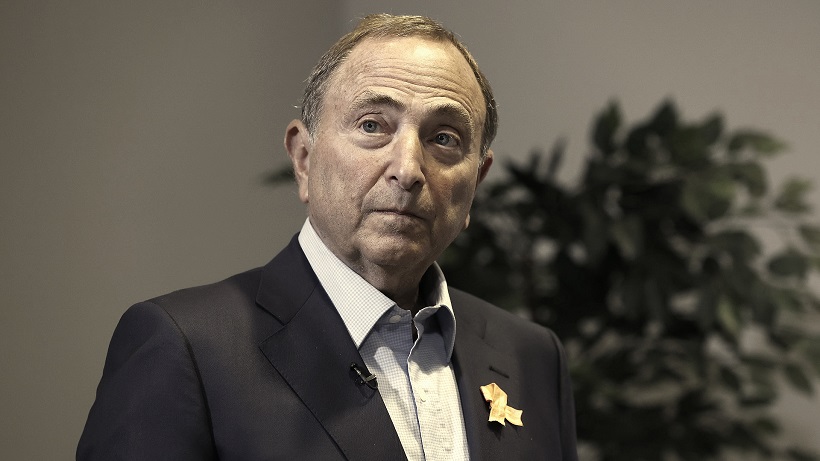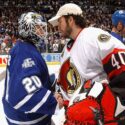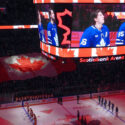TORONTO (Dec. 19) — Through no fault of its own, and with rapid suddenness, the National Hockey League is watching its 2021–22 season go down the drain. Or, at least form a huge vortex near the drain.
Until the final week of November, there was little concern that COVID–19 would substantially impact the NHL. Players, coaches and team personnel were said to be fully vaccinated (with two doses) and awaiting authorization for booster shots. Then came the news of another COVID strain originating in South Africa called Omicron. Quickly, and inevitably, it arrived in North America; airborne and frighteningly transmissible. It soon began to affect players in the NHL and other pro leagues. By Dec. 14, games began to fall (Calgary at Nashville, Carolina at Minnesota). Then, two days later, Toronto at Calgary. This was promptly followed by news that the Government of Ontario was reducing capacity to 50 percent in venues larger than 1,000 (which included NHL arenas in Toronto and Ottawa); then, absent a similar restriction by the Province of Quebec, that last Thursday’s Philadelphia/Montreal game would be played without fans at the Bell Centre. As the weekend unfolded, six teams (Calgary, Florida, Colorado, Boston, Nashville, Detroit) were forced to suspend activity. With COVID finally spreading through the Toronto Maple Leafs’ roster, weekend road matches in Vancouver and Seattle were postponed.
Today, with Columbus the latest team to sustain infections, the NHL announced that all cross–border games would be canceled until after the Christmas break. Why the league is permitting any competition is a matter of conjecture. And, somewhat alarming. Omicron, it seems, is just getting warmed up. Once it emerges from the pathogenic bullpen, governments and professional sports leagues will be entirely at its mercy; the COVID vaccines evidently powerless to diminish its spread. How, then, can any person reasonably expect the NHL to resume normal activity on Dec. 27? Or, at any time thereafter? Unless the league completely thumbs its nose at the Omicron element and allows asymptomatic players to suit up — thereby eliminating the 10–day isolation period upon testing positive — there is no plausible avenue to recommencing the 82–game season. And, it is unimaginable that players would agree to such a wayward scheme, endangering their health and that of their families.

GARY BETTMAN’S WORST NIGHTMARE — UNFATHOMABLE UNTIL THE END OF NOVEMBER — COULD BE ON THE HORIZON. THE NHL COMMISSIONER IS LIKELY CONFRONTING AN INDOMITABLE FOE.
Hockey, inescapably and against all inclination, will be forced into an indeterminate pause. An impenetrable barrier will arise if another closure is enacted at the Canada–USA border. Any such travel ban, hardly out of the question, will wipe out the existing league schedule, either obliterating a large and indefinite portion of the post–Christmas season or mandating an entirely new slate of games involving the all–Canadian division of a year ago.
The salary cap, flattened by the initial virus, will remain status quo… or recede.
Only a prompt and entirely unforeseen abatement of the Omicron outbreak will counter the aforementioned scenario. And, allow the NHL season to proceed without further interruption. Clearly, the Gary Bettman administration cannot be anticipating such an outcome. This is absolute hell for the league as it pertains to game tickets already purchased; to advertising, television and radio commitments. And, so bloody unexpected until just more than three weeks ago. That, however, is the abhorrent nature of the most–widely transmissible pathogen in modern human history. Neither will Omicron be the last of the coronavirus branches. No one can predict when the next variant will emerge… and from which part of the globe. But, it’s almost certain that COVID–19 will continue to stubbornly mutate and wreak havoc on our daily lives. Under no circumstance will the NHL escape such widespread disarray.
Here in Toronto, it is particularly galling. Yet another season of contract obligation from the Maple Leaf nucleus of John Tavares, Auston Matthews, William Nylander, Mitch Marner, Morgan Rielly and Jack Campbell — arguably, the top sextet in the league — could be nullified. If, in a worse–case scenario, Omicron negates a Stanley Cup tournament, the Toronto championship drought, longest in the NHL, will expand to 55 years. With only two seasons of control left among Matthews and Nylander; three for Marner. Just when it appeared the Leafs, with elite goaltending, might threaten their playoff famine dating to 2004, all elements of the 2021–22 season are in peril.
Some will surely argue that I am painting a doomsday scenario. Yet, without a smidgen of contrary evidence.
Again, such is the nature of COVID–19.
Never has an element of our existence been so completely indomitable.
EMAIL: HOWARDLBERGER@GMAIL.COM




































Howard, you should take the time to watch Vincent Racaniello. He says there is a lot of bad information being reported now.
He is an expert. A virology researcher lectures at Columbia and wrote the 1200 page Principles of Virology
He says breakthrough infections are normal and were always expected. The vaccines are doing their job and keeping most people out of the hospital.
Get vaccinated and get the booster and you have nothing to worry about.
I hope he’s right. But, we’ve also had a United States president say that COVID “will disappear… just like things disappear” and encourage people to inject Pine Sol into their veins. So, we must be careful when we hear words and try to obtain both sides of the issue.
Howard,
Here is my smidgen of evidence: This is not March 2020 and we are not at Ground zero against Covid-19. For all its ferocious transmissibility, Omicron variant has not put bodies in the hospitals (or has caused death) at the same rate as its predecessor variants. I am not claiming to be an expert, I am merely studying the trends in countries which Omicron is running rampant (example: South Africa, UK, and now Canada), and encourage you to do so as well.
Of course, there have been many worrisome “breakthrough” infections, but there seems to be clinical evidence (thus far) that fully vaccinated people are protected against SEVERE variant outcomes, while boosted people are able to avoid the infection altogether (or be asymptomatic/mild at the worst possible outcome). Good news: Almost 80% of all Canadians and apparently 95%+ of all the NHL Players are fully vaccinated, with the booster rates ramping up fast.
So, the question then becomes, should/would the NHL be forced to cancel the season, as players get sick for what seems to be like anywhere from 7-10 days, and to this day ALL have made full recovery (again, thanks to their high vaccination rates)? Certainly, I don’t think NHL will decide on cancelling its season if other major league sports decide to continue their respective seasons in some way, shape or form. Somehow, I don’t see the NHL to want to be the league of “health consciousness” by throwing NHL contracts into the grind by cancelling its season.
Another point to ponder as well: There will be other highly transmissible variants in the future as well. Should the NHL, then, just cancel their season in mid flight every time that is the case ( i.e. every year/almost every year)? What would be the point of having the NHL as a league to begin with?
“Shut downs” can’t be the answer to everything Howard, specially now that we have the tools to fight back against Covid-19 and its variants.
This is not Mach 2020, and we are not at Ground Zero against Covid-19.
Then the NHL has to change its COVID protocol rules. Right?
I saw the article earlier tonight from Frank Seravalli. Ok Howard, I am curious. Do you think this will come to the point where they will have to cancel the entire season and forego the playoffs in doing so? Regardless of where teams are in the race and what “may have been?”
I have no idea. What I do know is what I wrote: Unless the NHL dumps its COVID protocol, players and teams will continue to shut down. Omicron isn’t going anywhere fast.
If I were the NHL/NHLPA, here is what I would do:
1. Scrap the Olympics this year. I think that ship has sailed, and it’s just going through the process right now.
2. Pause for four weeks immediately, with the goal of tracking the hospitalization, ICU and Death rates across NA.
3. If, as we are seeing in Ontario thus far, the above rates continue to stay within reasonable thresholds, you can restart in 4 weeks from now.
4. Any restart, would of course require a shift in current COVID protocols. There are too many scenarios to be considered in this space. Things like taxi squads, reduced quarantine periods, etc. I don’t know what the right answer is (if there is one), but given 4 weeks, I’m sure it can be figured out (or not?!?).
5. Should the above stated metrics move beyond what is considered a reasonable threshold, then we’re back to planning for a playoff bubble again, or perhaps scrapping the season. Remember, the bubble was a complete financial loss for the owners. Not sure they’d be willing to do that again. My guess is that they would bite the bullet and do it, for the long term good of the game. That said, I have no idea what kind of incentives were provided by governments back then and whether those incentives would be offered again.
Anyway, this is just conjecture at this point. Back in 2019, I did call the playoff bubble format fairly accurately, and pretty early on in the pandemic (in this space I might add). From a business perspective, it comes down to risk management and problem solving, coupled with the notion that the NHL believes that it has a role to play in providing entertainment for fans during the pandemic.
All in all, I think they’ll do whatever they can short of bankruptcy to keep the season alive.
Bubble won’t work this time. Players are getting each other sick. Omicron is airborne.
The NHL and NHLPA have agreed to an extended Christmas break from 12/22 to 12/26. Platers must report to practice facilities on December 26 to conduct additional testing.
Then what?
A cancellation of the entire postseason due to the Omicron variant will cause a significant change to the draft lottery to make it similar to what happened in the draft lottery following the 2004-05 lockout. Each team would get a maximum of 4 lottery balls each. One lottery ball would be taken away for each playoff appearance that a team had over the past 4 completed seasons and one lottery ball would be taken away for each first overall pick a team had in the past five drafts. Teams who had more than 1 playoff appearances or first overall picks during that timeframe would receive one lottery ball each.
4 lottery balls: Seattle
3 lottery balls: Anaheim, Detroit, Los Angeles, Ottawa
2 lottery balls: Buffalo, New Jersey, Philadelphia, San Jose (New Jersey won first pick in 2019; Buffalo won first pick in 2018 and 2021)
1 lottery ball: Arizona, Boston, Calgary, Carolina, Chicago, Colorado, Columbus, Edmonton, Florida, Minnesota, Nashville, New York Rangers, New York Islanders, St. Louis, Tampa, Vegas, Vancouver, Winnipeg (New York Rangers won first pick in 2020 after being in playoffs)